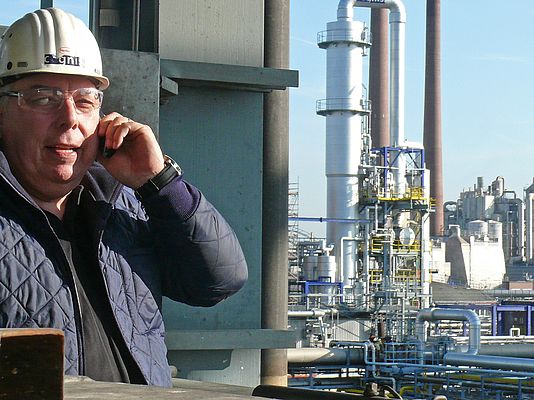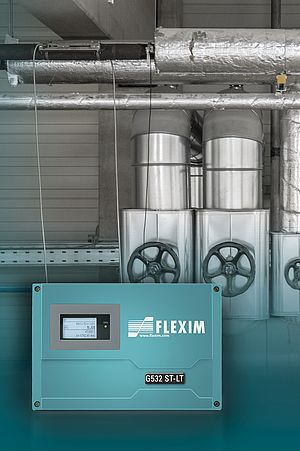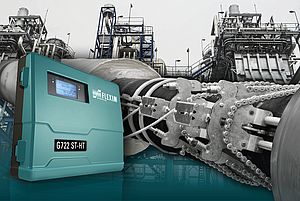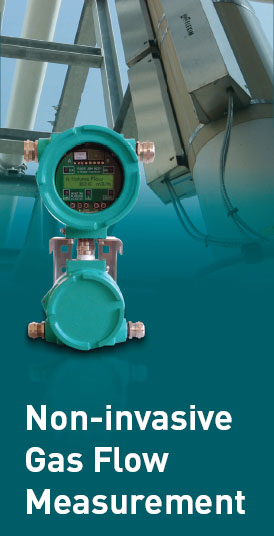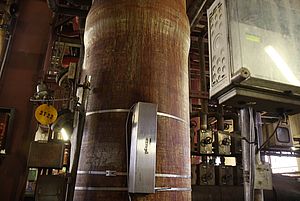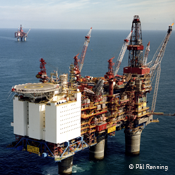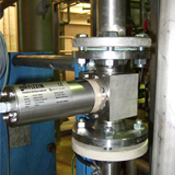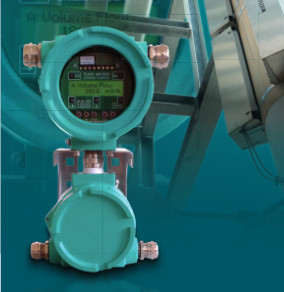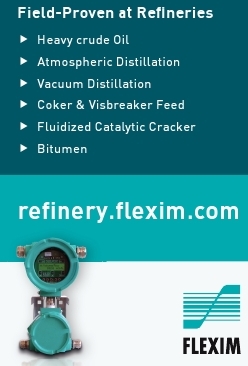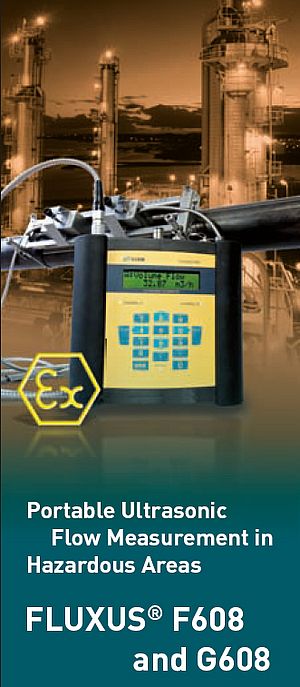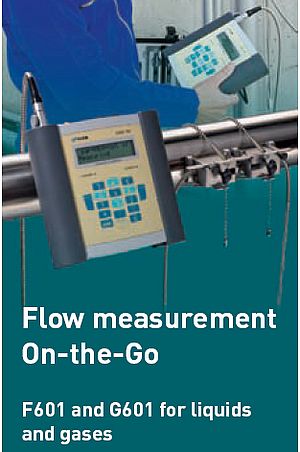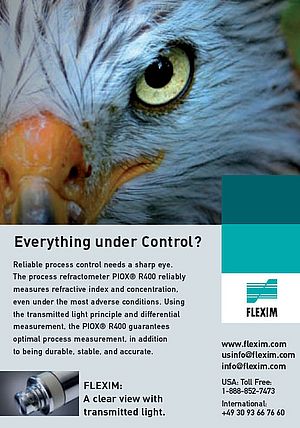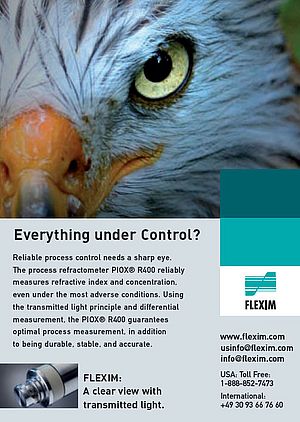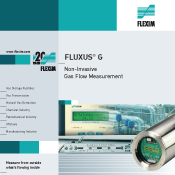The Düsseldorf speciality chemicals company Cognis sources a large amount of its raw materials from renewable natural products. Just as modern is its measuring technology, applying non-invasive flow measurement of a hydrogen mixture during the production of fatty alcohols.
Non-invasive ultrasonic technology using externally mounted clamp-on transducers has long been an established standard method for liquid flow measurement. Particularly in the chemical industry where aggressive and hazardous media are often used, experts favour this method. Non-invasive measurement means: no wear and tear by the medium and no risk of leakages. These advantages are not only limited to just fluid states of aggregation.
For the past few years, ultrasonic measuring technology has proven to be more and more effective for the flow measurement of gases. Ultrasonic measuring technology is increasingly used particularly during the production, transportation and injection of natural gas. However, in many areas, potential users still have the same reservations about this method. These reservations also had to be dispersed when it came to clamp-on liquid flow measurement. Applications that work without any problems are the best way of convincing sceptics. Non-invasive ultrasonic clamp-on technology is virtually predestined for the flow measurement of process gases. An example of this is the non-invasive ultrasonic flow measurement of hydrogen mixtures at Cognis in Düsseldorf.
Exemplary sustainability
Forward-looking measuring technology is not the only example set at Cognis. The specialist chemical company focuses particularly on renewable raw materials, products and services which allow the processing industry and end users to work ecologically and economically. This also includes the production of fatty alcohols. Fatty alcohols are an important primary product for many detergents and creams. Basic materials for the production of fatty alcohols are natural products such as coconut oil or palm oil. They are broken down into glycerine and fatty acid, the fatty acid is esterified and then hydrated.
Hydrogen serves as a circulating gas during hydrogenation. It works both as reactant and as means of transport. In order to be able to adjust the amount of circulating gas for process control, the volume flow must be measured as accurately as possible. In addition, by measuring the circulating gas, experts are able to detect if the piston compressor, which keeps the plant running, suffers any power loss caused by wear and tear.
Non-invasive measurement
Usually, turbine meters measure the flow rate of gas which flows at a high pressure. This is also the case at Cognis. In the fatty alcohol production plant at Cognis, Hans-Georg Linsner is responsible as planner for electrical engineering, measuring and control technology as well as automation. He describes the exceptional strain put on the turbine meters by the physical conditions. “Due to significant wear, their bearings have to be changed regularly. The meters are destroyed by liquid sloshing which happens occasionally.” Plant availability is affected by the fact that wetted, mechanical measuring devices are susceptible to wear and tear. “The plant needs to be shut down when installing and removing turbine meters.” For this reason, experts at Cognis decided to change the system.
Dependable technology
These problems are not an issue for non-invasive, ultrasonic gas flow measurement. Since clamp-on ultrasonic transducers are simply attached to the outside of the pipe, they are not subjected to wear by the medium. It can be fitted during ongoing operation. In addition to that, the high pressure level does not incur additional expenses for extra instruments. There is also no need to install or remove the turbine meters for the prescribed pressure tests that are carried out regularly with water every five years.
For Hans-Georg Linsner, it is important that the contact person is just as reliable as the measuring devices. Flexim’s sales engineer Heinrich Brucks is his reliable partner. He has already installed and commissioned many FLUXUS G ultrasonic measuring systems for clamp-on flow measurement of gases, particularly in gas storage facilities on the German-Dutch border. Heinrich Bruchs still considers non-invasive gas flow measurement as something special. “Ultrasonic clamp-on technology is certainly an extremely elegant and beneficial method for gas flow measurement, non-invasive gas flow measurement is by no means trivial”, he says.
Demanding acoustics
The challenge lies in the difficult acoustic conditions. As with the flow measurement of fluids, FLUXUS G ultrasonic measuring systems also measure gas flow according to the transit-time difference method. The acoustic transducers mounted on the pipe send and receive ultrasonic signals that are irradiated into the pipe both in and against the direction of flow. The flow velocity results from the measured transit-time difference and the geometry of the measuring points. In contrast to the simple clamp-on flow measurement of liquids, only a portion of sound is irradiated into the medium that is to be measured during gas measurement.
“The portion of sound energy transmitted into the gas is determined by the acoustic impedances of the gas and the pipe wall”, explains Dr. Bernhard Funck, from FLEXIM’s headquarters in Berlin. “The closer the respective acoustic impedances are, the more sound is transmitted from one medium to the other“. At normal pressure, this means a ratio of approx. 30000 between the acoustic impedances of steel pipe walls and gases, i.e. only a fraction of the irradiated energy gets into the gas. “The remaining sound stays in the pipe wall and acts as ambient noise there. In order to separate useful and interfering signals, the measuring transmitter takes on the roll of a digital Cinderella to a certain extent.
Since the density of gas rises with increasing pressure and its acoustic impedance converges towards that of the pipe wall, coupling of the ultrasonic signal under high pressures is much better. This is why the non-invasive measuring method works very well under high and very high operating pressures which are often associated with a great deal of time and effort as well as high costs. The company is at the forefront of research when it comes to developing the transition of a solid material to gas. As a result of several innovations and improvements in all areas of signal generation, insertion and processing, the cost of non-invasive gas flow measurement could be lowered repeatedly.
Superior through experience
“Thanks to the work of our developers, we have made huge advances in the last few years. So much so that we can even measure compressed air non-invasively”, says Heinrich Brucks delighted: “an enormous market!” As an engineer, Heinrich Brucks is a realist and therefore doesn’t feel competent when it comes to miracles. “That’s why we don’t promise any. “Of course, there are also cases where our measuring technology doesn’t work”, he admits. “but maybe it’s just a case of it not working yet”, he adds optimistically. Non-invasive ultrasonic technology even shows its advantages in failure: “With the portable FLUXUS G 601 measuring transmitter, I can go on site and check if the flow measurement is working correctly and which transducers are most suitable.”
Even when Heinrich Brucks doesn’t manage to make an offer after the test measurement, he doesn’t look on the time spent as wasted. FLUXUS G series measuring transmitters have high performance diagnostics tools which allow even inexperienced users to give their verdict on the accuracy and reliability of the measurement. For the professionals in FLEXIM’s development department, the measurement data provides important information for improving signal insertion and digital processing.
Meanwhile Hans-Georg Linsner of Cognis is satisfied. Since the non-invasive FLUXUS G 800 ultrasonic measuring system was commissioned in December 2007, process gas flow measurement has been working reliably and without any problems at Cognis.
Measurement of process gas
with Non-invasive ultrasonic flow meters
- by FLEXIM GmbH
- October 5, 2011
- 383 views


